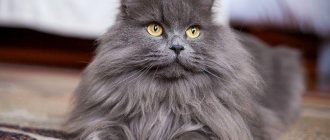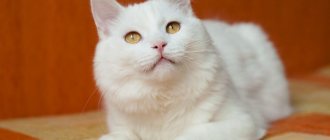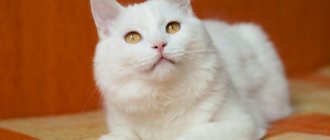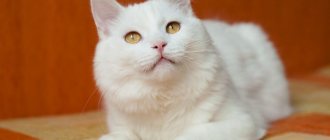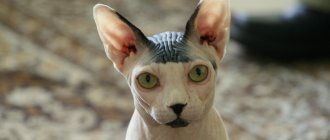Origin of the breed
The homeland of the Korat cat breed is Thailand.
The first written mentions of it date back to the 14th century. The name of the breed is given by the name of one of the provinces of the country. It is believed that the animals originated from the town of Ampur Pimai. The Thais call Korat cats “blue happiness” (Si-Sawat). In the east, it is shrouded in myths; animals were credited with magical powers: bringing wealth and good luck to their owners, protecting crops from drought and bad weather.
Animals appeared in Europe in the 19th century. Korats were presented in 1897 at the National Cat Club exhibition in Great Britain. By mistake, the contestants were mistakenly mistaken for representatives of the Siamese breed and disqualified for not meeting the standard.
Korat breeding began in the United States in 1958. The owner of the Cedar Glen nursery received two kittens of this breed as a gift. By the mid-sixties, the breed became popular. But the CFA received official recognition only in 1966. English felinologists considered Korat cats to be an independent breed only in 1976. Si-Sawat received the champion title at the national British cat show in 1983.
Application
Pets of this breed are excellent companions for people who spend most of their time at home.
The active, but not meticulous nature of the animal will not make a person bored, and its gentle character will not cause additional trouble.
Korats have blue eyes as children, which may later change color.
Note! Korats have a well-developed hunting instinct. However, the pet is rarely used as a mouse catcher. The reason is the high price of the cat. When wondering how much a Korat costs, a person learns that for a kitten you will have to pay up to 400-500 dollars.
Korats have established themselves as regulars at exhibitions.
The rare animal receives high praise from both event visitors and judges.
Description and appearance
Males and Korat cats are medium-sized but muscular animals. The average cat weighs 4-5 kilograms, a cat weighs 2-3 kilograms.
The standard defines the following parameters:
- The head is shaped like a heart. The forehead is large, flat, and the lower jaw is well developed. The brow ridges form the upper part of the “heart”, the muzzle gradually tapers downwards.
- Nose with a pronounced stop.
- Large eyes set wide apart. They give the muzzle a wary or surprised look. Acceptable iris colors: green, golden-green. Kittens are born with amber or yellow eyes, which change color by the age of two or four years.
- Large ears are set high. They are wide at the base and rounded at the tips. The hair on the outside of the ears is short, the inside is almost hairless.
- The tail is proportional to the body, tapering towards the tip.
- The body lines are smooth. The chest is wide, the back is smoothly curved.
- Strong limbs are proportional to the torso, the front ones are shorter than the rear ones. The feet are oval in shape, with five toes on the front and four on the back.
Visible tail breaks and more or less toes are not allowed.
Coat and color
Korat cats have short hair, with short, fine hairs lying close to the body. There is no undercoat. When the animal moves, the fur spreads out in “waves” along the ridge.
One color is allowed - silver-blue. Silvery hairs form a halo. The more there are, the higher the animal is valued.
Kittens may be born with an undefined tabby pattern. By the year it goes away.
Any deviation from the color is a reason for disqualification. White hairs, spots, medallions are unacceptable.
The lips and nose are dark blue, perhaps lavender. The standard sets color options for paw pads from dark blue to lavender with a pink undertone.
Konya
The description of the Konja cat in Tamra Maew is interpreted with slight differences. In the treatise, the cat is given the name Ninlarat, which is translated as “dark sapphire” or “onyx” - the horse owes this name, of course, to its fur coat, black and shiny, like the night itself.
In some ancient documents, the description of the horse is given as a separate poem; in it, the “onyx cat” has not only a black skin, but also eyes, teeth, claws and even a tongue! Probably, this description was generated by the wild imagination of the authors, who compared the Konya cat with the Singha lion (“Singha” is also the name of a beer popular in Thailand; anyone who has been to the land of smiles knows) - a monster from Thai mythology. Allegedly, the horse has the same stately, elegant gait as the fairy-tale lion.
Konya in Tamra Maew
The eye color is described as the bright yellow of a pumpkin flower. The ancient Konyas also had a white stripe that extended from the chin across the entire belly, but the descendants of that Konya that have come down to us are completely black, which is why this breed is often confused with the Bombay cat (although there are fundamental differences in the phenotype).
The golden-eyed onyx horse is still found in many temples. They say that if you treat this cat with something tasty, it will definitely bring you good luck.
Characteristics
Korats become attached to their owner and need attention and affection. Human company is important for a pet; prolonged loneliness has a detrimental effect on the psychological state of cats. The animal will enjoy spending time surrounded by all family members.
By nature, male cats are confident and purposeful. They are smart and easy to train. They are easy to teach to rules and routines.
Animals have developed emotional intelligence. They sense the owner’s mood and help relieve stress.
Animals do not strive to climb to heights. She will attract the cat if she needs to explore a new object. Korats prefer to watch what is happening while lying on the sofa or the floor, or the owner’s lap.
Representatives of the breed are frightened by loud, sharp sounds. They hide when they hear a vacuum cleaner or the sound of a drill. Animals cannot stand swearing or screaming. An unfavorable emotional climate in the home leads to deterioration in the health of pets.
The attention of all family members is important to Korat. They get along with children, but do not tolerate unceremonious attitudes. Aggressive behavior is responded to with aggression. Guests, especially noisy ones, irritate them. The cats try to hide until they leave.
Males and Korat cats get along only with their own kind. Representatives of other breeds irritate them. They do not get along with dogs and perceive guinea pigs and parrots as prey.
Korats are talkative, but meow loudly in extreme cases (illness, hunger). Cats attract attention with quiet, melodic sounds.
Animals do not want to go outside. They will not run out of an open door or window. But they love to lie on the windowsill and watch street life.
Reviews from Korat cat owners
Korat owners evaluate not only the attractive appearance of the pet, but also its character and habits. Some people's blue cats show their "unchildish" character. Of course, the owners immediately rush to share this with other people.
He loves to wash everyone - sometimes he licks their nose, sometimes their hair, and at the same time he also holds them with his paws so that they don’t clean them up! In short, a Korat cat is a miracle: smart, affectionate, and easy to train. Brings good luck and happiness to the house!
Elena, forum user
https://www.baby.ru/blogs/post/118659685–62192170/
I have a green-eyed Korat cat named Paprika, she is big and serious. We also have a dog trained not to hurt cats. But Paprika herself always attacks big dogs and cats that come into the yard.
4le, forum user
https://www.mihav.com/en/forum/cat-breeds/does-anyone-have-a-korat-kitten-276741/
Maintenance and care
Korats value comfort. Instead of mazes or climbing structures, your pet should buy a comfortable bed. It is better to place the basket in a secluded place.
The pet should have enough toys. Smart Korats prefer “intellectual” entertainment.
Cats are smart, quickly accustomed to the tray and feeding regime. They understand the prohibitions. You won't be surprised by your pet at the dinner table. If there is a scratching post, animals will not damage furniture or wallpaper.
Korats are not suitable for walking on their own. Breeders recommend walking your pet on a harness two or three times a week. You can accustom a kitten to such walks after six months.
To prevent the animal from getting bored, two representatives of the breed are adopted at once. This makes it easier for the Korats to endure loneliness.
Raising a kitten begins at an early age. If you don't teach your pet to discipline right away, he will act out. It is difficult to wean a Korat from “bad habits”.
Tips for owners
These cats need constant communication and attention from the owner. There is no need to leave them alone for a long time, they may become sad. And so Korats are not problem animals.
- Where can I take veterinary courses and what are they for?
Akita Inu. What kind of breed is this and what are its characteristics?
Siamese cat - description of the breed, character and features of caring for Siamese cats (105 photos and videos)
Care and hygiene
Short, fine coat without undercoat does not require frequent brushing. It is enough to do this once every 5-7 days. A soft brush with natural bristles or a special rubber mitten will do. During the molting period, the cat is brushed three to four times a week.
Cats and cats do not need frequent washing. Water procedures are indicated as contamination occurs. After bathing, the animal is dried with a terry towel, wrapped in it for 5-10 minutes. The fur does not need to be combed. After drying, it is given shine using a piece of suede fabric.
The pet's eyes and ears are examined daily. Every other day they are wiped with a cotton pad soaked in a special solution. Use a separate cotton swab for each eye and ear.
The animal's teeth are brushed once a week with a special paste. The kitten is accustomed to the procedure from three to four months. Nails need to be trimmed every 7-9 days.
Grooming activities
Caring for a short-haired, clean kitty will not cause problems; brushing is carried out once a week, bathing as needed twice a month.
- You will need to trim your nails, clean your ears, teeth, and eyes.
- These are adherents of cleanliness; they will not go near a dirty bowl or poorly washed tray.
- The master bedroom is the best location for the house; the pet will be calm, feeling completely safe next to the owners.
Nutrition
Most breeders recommend feeding Korats with premium food. Choose from lines for short-haired, active breeds.
If a natural diet is assumed, then 90% of it should consist of lean meat.
The diet includes:
- beef, veal;
- chicken or turkey meat;
- rabbit meat;
- lean pork;
- offal (liver, kidneys).
Three or four times a week the pet is given eggs, cottage cheese, milk or fermented milk products. Boiled or stewed vegetables and cereals are allowed once every seven days. They are given as an addition to meat. Fish and seafood are included in the diet three or four times a week.
An adult cat is fed two or three times a day. Kittens and pregnant or lactating cats require more frequent feeding up to four times a day.
In addition to the natural diet, the animal is given multivitamin complexes twice a year. Veterinarians recommend planting special grass for cats. It is especially relevant in the winter-spring period.
Health and life expectancy
On average, Korats live 15-17 years. Some pets lived up to twenty years.
Representatives of the breed must be protected from hypothermia and drafts. They are prone to colds.
Cats and cats often have food allergies. They are manifested by hair loss and redness of the skin. This feature complicates the selection of dry food.
Animals are predisposed to the following genetic diseases:
- gangliosidosis (retardation in physical development);
- atelosteogenesis (improper bone formation).
The first vaccinations are given to Korats at six months. Revaccination is carried out after 3-6 months.
If the animal is not planned to participate in breeding, it will be castrated. Cats are neutered or spayed at 8-10 months of age. It is better to do this before the first heat. Males are neutered before they reach one year of age. The optimal age is 7-10 months. If you monitor your pet’s diet and avoid overeating, obesity and related diseases will not overtake him.
Characteristic
Korats are affectionate, loyal and sociable. Pets passionately adore their owners, feel sad when parting with them and cannot stand loneliness. If you are not home much, then this breed is not for you.
They are unusually inquisitive and inquisitively explore the world. Everything around is controlled by the gaze of these wonderful emerald eyes. Cats are not very fussy, although they are energetic. They are not hostile, but will fight back against their opponent.
Korats have a wide range of sounds that help express wishes to the owner. At the same time, clear facial expressions express the mood.
Breeding
Crossing Korats with other breeds is prohibited. Animals that 100% comply with the breed standard are allowed for breeding. Before mating, it is necessary to have your pet examined by a veterinarian; vaccinations are given two or three months before mating. In addition to the usual examination, cats are shown an ultrasound of the abdominal organs.
Korats are fully mature by the age of three or four years. It is not recommended to breed a female before this age. The gap between pregnancies in a cat should be a year. This will allow the animal's body to recover.
Pregnancy in Korat cats lasts 65 days. As a rule, this period passes without complications. It is better if the birth takes place in the presence of a veterinarian.
Representatives of the breed do not leave their kittens for the first weeks of life. They are ready to protect them and can react aggressively to strangers.
Accompanying illnesses
Natural selection has become a guarantee of excellent health. Long-lived cats live up to 20 years with appropriate care and well-organized nutrition.
- There are genetic diseases such as atelosteogenesis, when bone formation is disrupted; it can be detected by DNA diagnosis and ultrasound.
- Possible gangliosidosis with neuralgic symptoms. Cats native to hot climates react to drafts and cold with colds.
Where to buy a kitten
The breed is considered rare in Russia and the CIS countries. One Moscow nursery, “Silvernertus”, deals with it.
The price of a kitten starts at 400 US dollars. The offspring of champions are many times more expensive. Rejected and excluded individuals from breeding are cheaper. But a mandatory condition for acquisition is castration or sterilization of the animal.
Some breeders of other breeds are ready to bring a kitten from abroad. Before using their services, check the authenticity of the documents and read the reviews. Fraudsters pass off rejected representatives of the Russian Blue or Burmese breed as Korats.
Please check the authenticity of the certificates and pedigree before purchasing. The kitten must have a veterinary passport with notes on vaccinations and previous diseases.
Korat cats are beautiful, graceful, and intelligent. They will be true friends. The breed is suitable for single people and families with children. But it is worth remembering that pets deprived of attention get sick more often and their life expectancy is reduced.
Purchasing a kitten
There are few nurseries in Russia that breed Korats. Such animals can be found from private breeders, but most often these are breeders who deal with Russian blue cats or British blue cats, so the future buyer needs to be very vigilant when choosing a baby.
A breeder I know told me that in our city (Penza) there are no such cats at all. I found several advertisements with Korat kittens and decided to contact one of the numbers provided. During a phone conversation, the breeder explained that the cats look like Korats, but in fact they are the offspring of a Russian Blue cat. When I asked why she was misleading people, the woman explained that most potential buyers are not interested in purebreds. They say that people often look for beautiful cats that look like purebred cats, but they don’t even ask about the kittens’ parents.
Most often, kittens of Russian blue cats are passed off as Korats.
How to choose a Korat kitten
Any purebred kitten must meet the following criteria:
- beautiful and well-groomed appearance, its compliance with the breed;
- breed-specific behavior of the baby;
- availability of necessary documentation;
- suitable age.
First of all, the kitten should look healthy. His ears, eyes and nose must be clean, as well as his skin, without wounds, scratches or other damage to the skin. The tail should be smooth (exclude kinks, knots and other tail defects), the tummy should be rounded, but not hard. The animal should be moderately active, playful and friendly. If a small cat is not easy to handle and shows aggression, then most likely he does not receive enough attention from his mother or people, or is afraid.
It is recommended to choose a kitten that will behave better and friendlier than the rest. I usually try to choose those babies who are easy to handle, but not intrusive. Pay attention to all the droppings. Some kittens will ask to be held and meow, and one kitten (usually the smallest) will sit in the corner and be silent. Such quiet people grow up withdrawn. I try to choose “average kittens”. They grow up kind and moderately active.
Only healthy and well-groomed Korat kittens will grow into beautiful and kind pets.
No less important is the documentation that the breeder has. The kitten must have a veterinary passport. In addition to photographs and information about the breed, this document contains information about all medical operations performed (if any) and vaccinations. In addition, the baby must have a pedigree. Such paper is required if the breeder calls a blue kitten a purebred. It lists the cat's parents. This is the only way to confirm the purity of an animal.
To make sure that this is a small Korat and not a simple gray kitten, you can try to recognize it as a blue Thai breed. Korat kittens are stockier and stronger than, for example, Russian Blue kittens. Their legs are shorter and straighter, and their body is more round.
Also, look at the baby’s fur. Russian kittens have a gray undercoat (thin downy hairs hidden in the main coat), but shorthaired kittens do not have such fluff. Part the fur with your fingers and look at the fibers. Their ends should be slightly lighter than the main part of the hair. Korat kittens also have a heart-shaped head almost from birth. The eyes of a silver cat will be gray-blue, but people usually don’t pay attention to their color at a young age. The paw pads should not be yellowish-gray like other gray cats. The tips of the ears should be rounded from birth.
When choosing a kitten, pay attention to the shape of the face and paws
The age of a kitten at which it is better to adopt it
The future owner of the Korat will want to take the pet when he is very young. There may be several reasons for this desire. Some people will want to see how the kitten grows and develops, while others will decide that moving the baby early will help him quickly adapt to new conditions. But in any case, it is not recommended to adopt a kitten until it is at least 3 months old.
One of the reasons for this restriction is the need for the mother to feed the Korat. A cat with colostrum gives its cub antibodies that create the primary immune system. In addition, it is the cat who gives the offspring a sense of security; she takes care of the health of her children and raises them. The cat watches how the calf switches to adult food, uses the tray, and sharpens its claws. Mother teaches kitten to communicate. Until two months he does not know his limits in the game, scratches and does not control his strength properly.
There is a psychological connection between a cat and her kittens. If you tear your baby away too early, he may grow up unstable (aggressive or withdrawn). This will affect the behavior of the animal in adulthood. A cat that has experienced such severe stress at an early age can damage furniture, bite and scratch, go to the toilet in the corners of the apartment, etc.
Up to three months, kittens must be fed and raised by a mother cat.
An equally important reason why a cat can be adopted only after 3 months is vaccination. Between 2 and 3 months the animal will receive its first vaccinations, because by this age the immunity received from the mother will begin to decline. To ensure your cat is healthy and survives in new, unusual conditions, adopt him no earlier than the recommended age.
There are exceptions. For example, if early weaning of a baby from a cat is necessary: the cat has died or is seriously ill, the sick kitten must be urgently isolated from healthy brothers and sisters, etc. But in this case, responsibility for the first vaccinations will fall on the shoulders of the new owner.

